Power System Operating Characteristics -
A convenience turned menace.
You would not consider the typical residential power system to be associated with disease, no less Leukemia, since Maximum Permissible Exposures (MPEs) are gargantuan relative to residential exposures, for both Electric (from Voltage) and Magnetic (from Current) fields. Nonetheless this is a ungly (inconvenient) fact that keeps reappearing with successive research. Of course, the power lobby is quick to "purchase other research" to try and debunk independent findings. But if (you knew) there was any question of possible negative bioeffects, what would you do? Willing to blindly take a chance?
By necessity, since no one wants a major power line or generator near their home, power generation and long-distance conveyance has been historically at high voltages, reduced to those voltages required near the user. Since Transformers allow easy change (increase or decrease) in voltage, long-distance electric power cartage has mostly been an alternating affair. Alternating because it continuously varies with time, and "affair" because its quality varies depending on nearby (or local) user. It\\'s been obvious that direct current systems were a dismal failure due to wire resistance and voltage drop, so Thomas Edison was history. This has been mostly Tesla\\'s world. Now with newer technology, we are flirting with high voltage DC power transmission for long distance cartage. 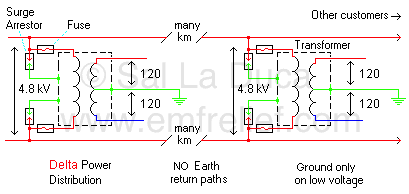
The first systems were of a lower voltage (sometimes as low as 2300 V), and separate from earth ground. Fuses were attached to any load device (transformer) to prevent large-scale outages, and surge arresters were also frequent to reduce lightning damage. Its construction also served as a lightning catch-grid, reducing lightning damage to nearby structures. This was the Delta system. Alternating electric fields were constrained near the proximity of the wires, since they were not referenced to the earth, and alternating magnetic Fields were also minimal. Life was good.
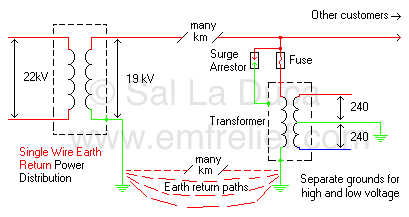
Tesla, however, was also experimenting with single-wire power transmission, using the earth as the second or return wire, also commonly referred to as the neutral / ground. Telegraph systems took this on as a successful engineering platform. Some countries, looking solely at the economics of the process, realized substantial gains by using a single wire to provide long-distance power, fully using the Earth as the return path. This was the Single Wire Earth Return (SWER) system. Due to its sparse density it was not much good as a lightning catch-grid. Being aerial (that is, up in the air) and now referenced to the earth, it provided quite a bit of alternating electric Field presence, as well as alternating magnetic fields because one path of current was concentrated in the wire, while the return was diffused over a vast region of soil, nearly eliminating any proximity-effect field cancellation.
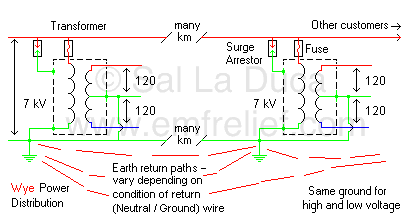
In North America, however, there was some apprehension with using the earth as the only return, so a return wire was included. This became known as a WYE system, where the (high voltage) Primaries\\' return / neutral wire was connected to the soil (grounded) and due to the design, interconnected to the (low voltage) secondary return / neutral / ground wire. Due to the languishing aspect of maintenance, the WYE system is becoming more and more like the SWER system. This is because the many connections (splices, crimps, etc.) on the neutral wire are exposed to the weather, and suffer expansion, contraction, rust effects, and become unreliable or broken altogether. Because of its ubiquity, it still serves as a catch-grid for lightning, and like the SWER system it provides an abundance of alternating electric and magnetic fields.
A variant of the above is the Underground Residential Distribution (URD). Due to the "ugliness" of poles and wires, and wanting an uncluttered neighborhood, the utilities were enticed in some areas to bury primary wiring between transformers, which were now dull color metal boxes on the ground. This eliminated alternating electric fields because the energized wiring was now immersed in a conductive matrix of moist soil. This system is a complete failure as a lightning catch-grid. It\\'s also a complete failure as far as alternating magnetic field reduction, because now instead of the wire being 30 feet up in the air, it is in the ground no more than 3 to 5 feet below the surface, making the field presence much stronger (if there is any imbalance in the supply and return current, and of course, in most cases there is imbalance). Since in some instances the primary neutral was an exterior unshielded wire twisted around the energized wire, and being made of Aluminum which corrodes quickly, this too began to take on the look and feel of SWER.
The earth has thus (intentionally or not) became a default current return path for the electrical distribution system. This set in motion a mechanism whereby a large percentage of the global population became exposed to a pervasive presence of alternating current in the soil, and a corresponding low-level alternating magnetic field. Whether the field or the current is the primal cause of effects, may be irrelevant, but effects began to surface. Some of the corollary effects of the alternating current in the soil, are that forcing such a current through a physical body that exhibits DC magnetic properties will tend to act as a magnetic eraser, (noticeably, the Earth\\\'s DC Magnetic field has been weakening (could this be an effect?)), and its travel is unpredictable (causing some areas to abound in surface-proximal current flow, and Magnetic fields) due to the soil\\\'s non-homogeneous electrical conductivity. The areas where surface-proximal current flow abounds can cause tangible tingle-voltage effects for animals in contact with the soil, or in contact with the soil and some metallic structure. Humans in bare feet can similarly perceive this tingle voltage, depending on age and the condition of the individual\\'s immune system. Due to the great monetary resources available to the power utilities (they purchase the best lawyers our money can buy) any allegation of cause-and-effect was and is aggressively disputed and fought either by discrediting the accuser, or with use of junk science and junk scientists, which still abound. 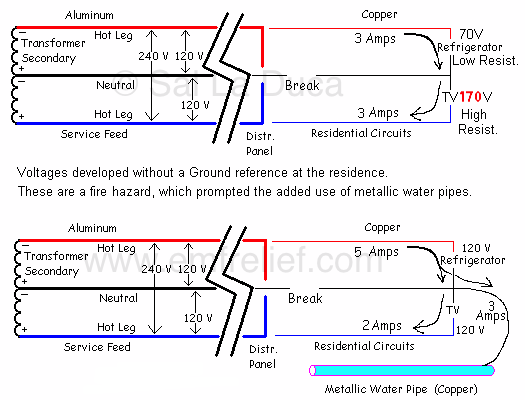
To add insult to injury, the North American residential distribution scheme, known as a split-phase system, is faulty due to the same languishing maintenance schedule. When has any homeowner been advised to have the integrity of their electric system\\'s connections verified? Loose and broken connections emerge, and due to the lack of direction, codes increase the complexity of the system to overlook the obvious. As shown at right, a single loose or broken connection can become a fire hazard. This can be identified as "bright and dim lights", where the differing intensities occur simultaneously on different circuits. The "code" stipulates that if there are metallic structures that can serve as a backup to the neutral wire, they will be interconnected to it. This will stabilize voltages, but cause circulating or "stray" currents onto every other metallic interconnection. This can be a metallic water pipe, TV cable shield, or telephone ground. A weasel clause, later in the same code, stipulates that if there is "objectionable current," the use of any of these redundant connections can be discontinued. They never address the initial poor design issue, nor do they quantify how much current is "objectionable". This is a legal document, so written that they cannot be held liable . . . sounds like the power companies had a hand in writing this code . . . What results are electricians who are busy installing new wiring, a few specialists who know how the interconnections actually function, frustrated customers, and ailing bodies whose number keeps increasing.
To add insult to injury, most indoor wiring is simply covered in plastic, which is transparent to alternating electric fields, bringing the power system\\'s derivatives indoors in full force, even if no current is being used. As an example, a client requested an EMF survey because of a 230KV major power transmission tower and line immediately nearby. Measuring for alternating magnetic fields there was no presence because the power line wires had currents that were reasonably balanced and provided cancellation. Measuring for alternating electric fields there was an intense presence indoors. Yet when the main breaker was opened (turned off), > 95% of the Electric Fields vanished, them being due to indoor energized wiring. The MPE for 60 Hz Electric fields has been deemed to be 5000 V/m, based on short term effects, with a safety factor included, and extrapolated to "acceptable" long-term exposure. Yet research has indicated a peak in childhood leukemia for ages 2 to 4 after homes were "electrified," with residential exposures only in the 1 to 10 V/m range!
Bringing in a little sloppiness into the soup, many electricians have helpers perform the brunt of the work. When a wiring error is introduced, circulating currents result in the affected circuit(s) providing for strong and unpredictable alternating magnetic fields indoors, distant from any power lines, even if everything appears to work fine. The MPE for 60 Hz Magnetic fields has been deemed to be 9040 mG, based on short term effects, with a safety factor included, and extrapolated to "acceptable" long-term exposure. Yet research has indicated a doubling of leukemia with long term exposure to levels above 4 mG, which can happen without predictability from plumbing currents as noted above, or from wiring errors as noted below.
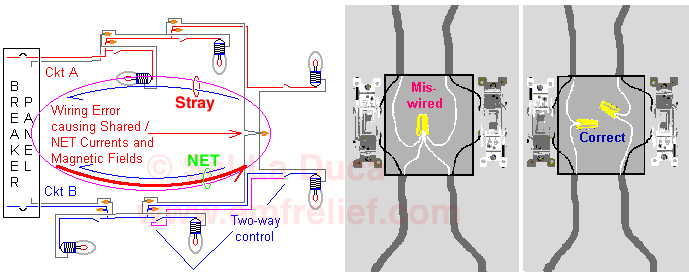
These last two issues are present even in systems that can be totally disconnected from a public utility, as in solar/wind-powered, because most individuals are clueless about the ramifications until after the negative effects are perceived, by which time the cost of corrective measures increases exponentially. As an example, an individual called from a remote area, indicating unpleasant biological response to the indoor solar-powered electric system that was distant, and disconnected, from any public power system. This individual had installed wiring just covered in plastic, as well as aluminum-foil-backed insulation near the energized wiring, making the alternating electric field presence perhaps greater by a factor of 10 compared to "conventional construction." Once the structure is built, the remediation costs are much greater, because the walls, floors, and ceilings may need to be opened to replace the wiring with a type that has a grounded metal armor (which eliminates electric field emissions).
Now referring to an issue little understood by homeowner and electrician alike, we come to Grounding. If one were able to use a voltmeter with very long leads (several miles/km long) and measure the ground connecting at istant points, it would be noted that they are several, and perhaps hundreds, of static (DC / Natural) and alternating (AC / Artificial) volts different from each other. With the Delta system it\\'s not so much a concern because the different grounding points are not solidly connected to each other, making the cause of "stray currents" a myth (caveat here due to suburban residential systems interconnected due to the indoor system\\'s major flaw (Achille\\' heel)). With the other two systems (WYE and SWER) it makes a major difference because now these differences in voltage will be the driving force behind the flow of currents in the soil. In some instances the grounding point to a local point of service can be electrically elevated from the ground around it, by as much as 15 to 25 Volts, based on my first-hand experience. The typical response of the electricians or electric company personnel is to sink additional ground rods into the soil. This is most idiotic because it simply adds more electrical contacts with which to drive more current into the soil. It only mildly reduces the "stray voltage" previously identified. What needs to be done is to identify the reason why the grounding point voltage is elevated, and correct it. However, this latter path is not the path of least resistance / cost, so it is seldom employed. In suburban and rural areas where elevated grounding-point voltages are identified, it is most likely a result of frayed or broken primary return wire. 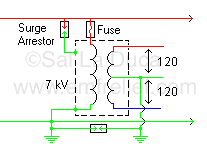 If a single customer is affected, and the transformer\\'s primary and secondary grounds are interconnected as above, the customer can request neutral / ground isolation at the transformer. The two grounds, now separated by 8 feet or more horizontal length of insulated wire to where the rods contact the soil, are interconnected with a surge arrester (somewhere on the pole), which will provide instant union during a surge to improve grounding, and once the surge is quenched the arrester again becomes an isolation device. A variant of this for a concrete-pad-mounted transformer will serve the same purpose. If more than one customer is affected, they all have to be in agreement, or the utility cannot help. Stray current issues in urban areas have similar causes, but their solutions are more complex because of the great number of interconnections.
If a single customer is affected, and the transformer\\'s primary and secondary grounds are interconnected as above, the customer can request neutral / ground isolation at the transformer. The two grounds, now separated by 8 feet or more horizontal length of insulated wire to where the rods contact the soil, are interconnected with a surge arrester (somewhere on the pole), which will provide instant union during a surge to improve grounding, and once the surge is quenched the arrester again becomes an isolation device. A variant of this for a concrete-pad-mounted transformer will serve the same purpose. If more than one customer is affected, they all have to be in agreement, or the utility cannot help. Stray current issues in urban areas have similar causes, but their solutions are more complex because of the great number of interconnections.
A corollary of, or "playful tinkering" with, electricity brought on the desire to control the output of lighting with other than a simple on/off switch. This feature is employed by an electronic variable control (dimmer) that turns on during a preset portion of each cycle. Since power is provided at 60 (or 50) cycles per second (Hertz or Hz), the equivalent result is a switch that turns on and off 120 times per second (turns on and off twice in each cycle, because it turns on during each of the two opposite-polarity pulses of energy, and turns off during the zero-crossing transition). Anytime a switch is turned on or off, there is a small arc which can easily be detected by a simple AM radio. If one could quickly sweep the frequency of that AM radio, it would be noted that the scraggly emissions occur throughout the entire range of reception (EMI / Radio interfrence, can be caused by electric utility equipment. Should that be the case, thy are obligated to correct it at no cost to you. Should you simply think they are Always the casue, you may be emabarassd to find your equipment can be the source!). Lightning does the same thing, on a much larger scale. A single low level burst of energy provides emissions detectable between 540 to 1700 kHz? Yes, and then some. Arcing during lightning rips various electrons out of atomic orbit of the surrounding air molecules / atoms. Since the various electrons have discrete energy levels binding them to the atoms, their return provides discrete emission at various energy levels and frequencies. Although indoor electronic light controls are assumed to occur within the enclosed structure of the electronics (a "protected" environment), the harmonics emissions are nonetheless similar to those of lightning. With a typical indoor wiring system, these emissions are scattered about on the supply wiring, becoming part-and-parcel of the alternating electric field emissions. The harmonic emissions, however, are much worse than 60 Hz alone because their coverage of frequencies from zero to greater than one MHz overlaps many frequencies of biological interest, and are most energetic in the low end of the audio range, which we are most sensitive to. Tinnitus anyone? Hello!
Fluorescent lighting in any form, is inherently non-linear, current-wise, light-emission-wise, and can be a disposal problem. Its current use requirements produce similar harmonics as produced by dimmers noted above. Although they are touted as energy efficient, their efficiency comes at a price. When they approach end-of-life, they can also acquire radio frequency interference source characteristics that may confound the technically ignorant homeowner. Along the same type of current use are Light Emitting Diodes (LEDs). Although they are very energy efficient and produce no electrical emissions (when driven by batteries (AND do not have any slick variable intensity controls)), when driven by AC power, they require a voltage reduction that is mostly provided by switching power supplies. These have current consumption very similar to fluorescents or dimmers. So for those who like to listen to distant AM radio, all of these sources become prolific interference sources. Ironically, human central nervous systems are likewise interfered with, because the principles of Electromagnetic Interference (EMI) are based on Amplitude Modulation (AM). Sometimes this can be manifest as sleep disruption, perhaps long after the exposure. So when you know what the problems can be, eliminating them at the outset can be quite rewarding.
Both Electric and Magnetic fields seem to be associated with leukemia in common residential exposures. If building new, the extra expense of installing armored (equivalent to shielded) wiring is very worthwhile. If buying used, the Electric field can be identified as to its most relevant source, and that turned off in areas where you sleep. If there is a Magnetic field presence, and in most cases this is the exception, the source can be identified and the wiring corrected to eliminate the source. Harmonic content (/ electrical "noise," / "dirty" electricity) from dimmers or other nonlinear loads seems to be associated with immediate central nervous system irritation. Replacement of all variable lighting controls with standard on/off controls, and of all nonlinear lighting (that is used often), is a worthwhile weekend project for anyone.